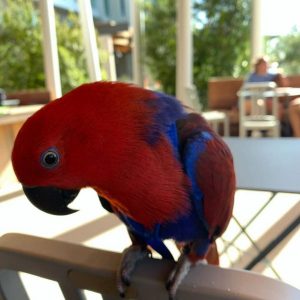Buy Parakeet Parrots Online
$0.00
| Bird ID | 181185 |
| Price | $1000.00 Each |
| Shipping | $100 |
| Total Available | 1 Unsexed |
| Age | Weaned |
| Weight | 0.8 Kg-2 Kg |
| Talking Ability | Yes |
Parakeet Parrots For Sale Online
A parakeet is any one of many small to medium-sized species of parrot, in multiple genera, that generally have long tail feathers. The Australian budgerigar, also known as “budgie”, Melopsittacus undulatus, is probably the most common parakeet. It was first described by zoologists in 1891. It is the most popular species of parakeet kept as a pet in North America and Europe. The budgie (parakeet) is often thought of as a “beginner bird,” however, this social, outgoing little bird deserves just as much care and attention as larger parrots. Budgies are playful, love food, and can rival any parrot in terms of talking ability. The vernacular name ring-necked parakeet (not to be confused with the Australian ringneck) refers to a species of the genus Psittacula native to Africa and Asia that is popular as a pet and has become feral in many cities outside its natural range.
Older spellings still sometimes encountered are paroquet or paraquet. In American English, the word parakeet usually refers to the budgerigar. Parakeets comprise about 115 species of birds that are seed-eating parrots of small size, slender build, and long, tapering tails. The term “grass parakeet” (or grasskeet) refers to many small Australian parakeets native to grasslands such as the genus Neophema and the princess parrot. The Australian rosellas are also parakeets. Many of the smaller, long-tailed species of lories may be referred to as “lorikeets”.
Parakeet Parrots Online
The dusky-headed parakeet (Aratinga weddellii), also known as Weddell’s conure or dusky-headed conure in aviculture, is a small green Neotropical parrot with dusty grey head found in wooded habitats in the western Amazon basin of South America. Its range extends from southeastern Colombia south through eastern Ecuador, eastern Peru and southwest Amazonian Brazil, to central Bolivia. It prefers semiopen habitats such as várzea, forest edge, and forest remnants, but can also be found in coffee plantations. It is generally common and its habitat preference makes it less vulnerable than many other Amazonian species. Consequently, it is considered to be of least concern by BirdLife International and IUCN.
4 reviews for Buy Parakeet Parrots Online
Add a review Cancel reply
Related products
Parrots Birds & Chicks
Parrots Birds & Chicks
Parrots Birds & Chicks
Parrots Birds & Chicks
Parrots Birds & Chicks
Parrots Birds & Chicks
Parrots Birds & Chicks
Parrots Birds & Chicks























Cecil –
Thanks for sharing your thoughts about website.
Regards
Kathlene –
Hi to every one, it’s genuinely a pleasant for me to pay a quick
visit this site, it consists of helpful Information.
Ashely –
Great work! This is the kind of information that are
supposed to be shared around the web. Disgrace on Google for
not positioning this submit upper! Come on over and talk over with my web site .
Thanks =)
Judy –
Hello very nice web site!! Guy .. Beautiful .. Wonderful
.. I will bookmark your website and take the feeds also?
I am satisfied to search out so many helpful information right here within the publish, we
want develop extra techniques in this regard, thank you for sharing.
. . . . .